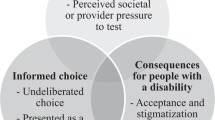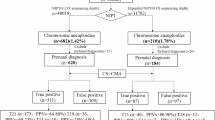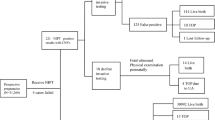Abstract
Prenatal fetal sex determination is clinically indicated for women who are at risk of having a child with a serious genetic disorder affecting a particular sex. Ultrasound has been the traditional method used, but early fetal sex determination using non-invasive prenatal diagnosis (NIPD) can now be performed using cell-free fetal DNA in maternal plasma. The study aim was to assess the views and experiences of service users who had used NIPD for fetal sex determination. In this paper, we report on the perceived benefits and disadvantages. A qualitative approach using semi-structured interviews was used. A total of 44 participants (38 women and 6 partners of participating women) were recruited. Participants’ views and experiences of NIPD were overwhelmingly positive. Concerning benefits over traditional methods, three themes emerged: (1) technical aspects of technology; (2) timing; and (3) enhanced decision-making. Practical advantages of NIPD included avoiding miscarriage, and there were a number of psychological advantages associated with timing such as perceived control, early re-engagement, normalization of pregnancy and peace of mind. Participants also valued NIPD as it enabled a stepwise approach to decision-making. A number of disadvantages were discussed including concerns about social sexing and increased bonding at a time in pregnancy when miscarriage risk is high. However, participants felt these were fairly minor in comparison with the advantages of NIPD. Until definitive genetic diagnosis using NIPD is available, NIPD for fetal sex determination is perceived as a good interim measure with a number of notable advantages over traditional methods.
Similar content being viewed by others
Log in or create a free account to read this content
Gain free access to this article, as well as selected content from this journal and more on nature.com
or
References
Finning KM, Chitty LS : Non-invasive fetal sex determination: impact on clinical practice. Semin Fetal Neonatal Med 2008; 13: 69–75.
Odeh M, Granin V, Kais M, Ophir E, Bornstein J : Sonographic fetal sex determination. Obstet Gynecol Surv 2009; 64: 50–57.
Emerson DS, Felker RE, Brown DL : The sagittal sign. An early second trimester sonographic indicator of fetal gender. J Ultrasound Med 1989; 8: 293–297.
Efrat Z, Akinfenwa OO, Nicolaides KH : First-trimester determination of fetal gender by ultrasound. Ultrasound Obstet Gynecol 1999; 13: 305–307.
Efrat Z, Perri T, Ramati E, Tugendreich D, Meizner I : Fetal gender assignment by first-trimester ultrasound. Ultrasound Obstet Gynecol 2006; 27: 619–621.
Hackett GA, Smith JH, Rebello MT et al: Early amniocentesis at 11–14 weeks’ gestation for the diagnosis of fetal chromosomal abnormality—a clinical evaluation. Prenat Diagn 1991; 11: 311–315.
Benacerraf BR, Greene MF, Saltzman DH et al: Early amniocentesis for prenatal cytogenetic evaluation. Radiology 1988; 169: 709–710.
Alfirevic Z, Gosden CM, Neilson JP : Chorion villus sampling versus amniocentesis for prenatal diagnosis. Cochrane Database of Syst Rev 2000 CD000055.
Caughey AB, Hopkins LM, Norton ME : Chorionic villus sampling compared with amniocentesis and the difference in the rate of pregnancy loss. Obstet Gynecol 2006; 108: 612–616.
Hyett JA, Gardener G, Stojilkovic-Mikic T et al: Reduction in diagnostic and therapeutic interventions by non-invasive determination of fetal sex in early pregnancy. Prenat Diagn 2005; 25: 1111–1116.
Devaney SA, Palomaki GE, Scott JA, Bianchi DW : Noninvasive fetal sex determination using cell-free fetal DNA: a systematic review and meta-analysis. Jama 2011; 306: 627–636.
Hill M, Taffinder S, Chitty LS, Morris S : Incremental cost of non-invasive prenatal diagnosis versus invasive prenatal diagnosis of fetal sex in England. Prenat Diagn 2011; 31: 267–273.
Lewis C, Hill M, Skirton H, Chitty LS : Fetal sex determination using free fetal DNA: Service users' experiences and preferences for how the service should should be offered in clinical practice. Prenat Diagn 2012, (in press).
Britten N : Qualitative interviews in medical research. BMJ 1995; 311: 251–253.
Braun V, Clarke V : Using thematic analysis in psychology. Qualitative Res Psychol 2006; 3: 77–101.
Strauss AL, Corbin J : Basics of Qualitative Research: Techniques and Procedures for Developing Grounded Theory 2nd edn Thousand Oaks, CA: Sage, 1998.
Zamerowski ST, Lumley MA, Arreola RA, Dukes K, Sullivan L : Favorable attitudes toward testing for chromosomal abnormalities via analysis of fetal cells in maternal blood. Genet Med 2001; 3: 301–309.
Kooij L, Tymstra T, Berg P : The attitude of women toward current and future possibilities of diagnostic testing in maternal blood using fetal DNA. Prenat Diagn 2009; 29: 164–168.
Kelly SE, Farrimon HR : Non-invasive prenatal genetic testing: a study of public attitudes. Public Health Genomics 2012; 15: 73–81.
Hill M, Finning K, Martin P et al: Non-invasive prenatal determination of fetal sex: translating research into clinical practice. Clin Genet 2011; 80: 68–75.
Sahin NH, Gungor I : Congenital anomalies: parents’ anxiety and women’s concerns before prenatal testing and women’s opinions towards the risk factors. J Clin Nurs 2008; 17: 827–836.
Wright CF, Burton H : The use of cell-free fetal nucleic acids in maternal blood for non-invasive prenatal diagnosis. Hum Reprod Update 2009; 15: 139–151.
Scully JL, Porz R, Rehmann-Sutter C : ‘You don’t make genetic test decisions from one day to the next’—using time to preserve moral space. Bioethics 2007; 21: 208–217.
Henneman L, Kooij L, Bouman K, ten Kate LP : Personal experiences of cystic fibrosis (CF) carrier couples prospectively identified in CF families. Am J Med Genet 2002; 110: 324–331.
Lakeman P, Plass AM, Henneman L, Bezemer PD, Cornel MC, ten Kate LP : Three-month follow-up of Western and non-Western participants in a study on preconceptional ancestry-based carrier couple screening for cystic fibrosis and hemoglobinopathies in the Netherlands. Genet Med 2008; 10: 820–830.
McConkie-Rosell A, Spiridigliozzi GA, Sullivan JA, Dawson DV, Lachiewicz AM : Longitudinal study of the carrier testing process for fragile X syndrome: perceptions and coping. Am J Med Genet 2001; 98: 37–45.
Anido A, Carlson LM, Taft L, Sherman SL : Women’s attitudes toward testing for fragile X carrier status: a qualitative analysis. J Genet Couns 2005; 14: 295–306.
van den Heuvel A, Chitty L, Dormandy E et al: Will the introduction of non-invasive prenatal diagnostic testing erode informed choices? An experimental study of health care professionals. Patient Educ Couns 2009; 78: 24–28.
Hill M, Compton C, Lewis C, Skirton H, Chitty LS : Determination of fetal sex in pregnancies at risk of haemophilia: a qualitative study exploring the clinical practices and attitudes of health professionals in the United Kingdom. Haemophilia 2011, e-pub ahead of print 23 September 2011.
Katz-Rothman B : The Tentative Pregnancy; How Amniocentesis Changes the Experience of Motherhood. New York: Norton & Company, 1993.
Heidrich SM, Cranley MS : Effect of fetal movement, ultrasound scans, and amniocentesis on maternal-fetal attachment. Nurs Res 1989; 38: 81–84.
Caccia N, Johnson JM, Robinson GE, Barna T : Impact of prenatal testing on maternal-fetal bonding: chorionic villus sampling versus amniocentesis. Am J Obstet Gynecol 1991; 165: 1122–1125.
Moyer A, Brown B, Gates E, Daniels M, Brown HD, Kuppermann M : Decisions about prenatal testing for chromosomal disorders: perceptions of a diverse group of pregnant women. J Womens Health Gender Based Med 1999; 8: 521–531.
Rapp R : Testing Women, Testing the Fetus: The Social Impact of Amniocentesis in America. New York: Routledge, 1999.
Armstrong DS : Emotional distress and prenatal attachment in pregnancy after perinatal loss. J Nurs Scholarsh 2002; 34: 339–345.
Lindgren K : Relationships among maternal-fetal attachment, prenatal depression, and health practices in pregnancy. Res Nurs Health 2001; 24: 203–217.
Rubin R : Maternal tasks in pregnancy. Matern Child Nurs Jl 1975; 4: 143–153.
Berkenstadt M, Shiloh S, Barkai G, Katznelson MB, Goldman B : Perceived personal control (PPC): a new concept in measuring outcome of genetic counseling. Am J Med Genet 1999; 82: 53–59.
Payne K, Nicholls S, McAllister M, Macleod R, Donnai D, Davies LM : Outcome measurement in clinical genetics services: a systematic review of validated measures. Value Health 2008; 11: 497–508.
Skirton H : The client’s perspective of genetic counselling - a grounded theory study. J Genet Couns 2001; 10: 311–329.
Sapp JC, Hull SC, Duffer S et al: Ambivalence toward undergoing invasive prenatal testing: an exploration of its origins. Prenat Diagn 2010; 30: 77–82.
Acknowledgements
We are grateful to the participants who were interviewed as part of this study. The National Institute for Health Research (NIHR) Program Grants for Applied Research program (RP-PG-0707-10107) and the Central and East London NIHR Comprehensive Local Research Network funded the research. LSC is partially funded by the Great Ormond Street Hospital Children’s Charity; the NIHR comprehensive Biomedical Research Center at University College London Hospitals NHS Foundation Trust and University College London. The research funded is independent and the views expressed in the paper are those of the authors and not necessarily those of the NHS, the NIHR or the Department of Health.
Author information
Authors and Affiliations
Corresponding author
Ethics declarations
Competing interests
The authors declare no conflict of interest.
Rights and permissions
About this article
Cite this article
Lewis, C., Hill, M., Skirton, H. et al. Non-invasive prenatal diagnosis for fetal sex determination: benefits and disadvantages from the service users’ perspective. Eur J Hum Genet 20, 1127–1133 (2012). https://doi.org/10.1038/ejhg.2012.50
Received:
Revised:
Accepted:
Published:
Issue date:
DOI: https://doi.org/10.1038/ejhg.2012.50
Keywords
This article is cited by
-
The influence of experiential knowledge and societal perceptions on decision-making regarding non-invasive prenatal testing (NIPT)
BMC Pregnancy and Childbirth (2020)
-
EMQN best practice guidelines for genetic testing in dystrophinopathies
European Journal of Human Genetics (2020)
-
Facilitating informed choice about non-invasive prenatal testing (NIPT): a systematic review and qualitative meta-synthesis of women’s experiences
BMC Pregnancy and Childbirth (2019)
-
Non‐invasive Prenatal Diagnosis for BRCA Mutations – a Qualitative Pilot Study of Health Professionals’ Views
Journal of Genetic Counseling (2016)
-
An easy test but a hard decision: ethical issues concerning non-invasive prenatal testing for autosomal recessive disorders
European Journal of Human Genetics (2015)



